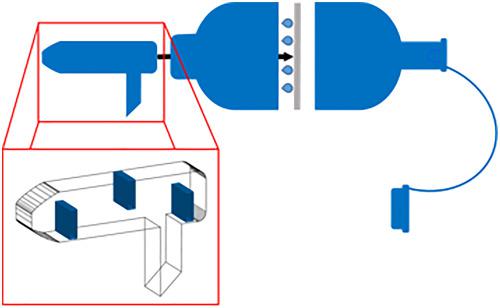当前位置:
X-MOL 学术
›
Drug Test. Anal.
›
论文详情
Our official English website, www.x-mol.net, welcomes your feedback! (Note: you will need to create a separate account there.)
Does oral fluid contribute to exhaled breath samples collected by means of an electret membrane?
Drug Testing and Analysis ( IF 2.9 ) Pub Date : 2019-04-23 , DOI: 10.1002/dta.2597 Ann-Marie Garzinsky 1 , Katja Walpurgis 1 , Oliver Krug 1, 2 , Mario Thevis 1, 2
Drug Testing and Analysis ( IF 2.9 ) Pub Date : 2019-04-23 , DOI: 10.1002/dta.2597 Ann-Marie Garzinsky 1 , Katja Walpurgis 1 , Oliver Krug 1, 2 , Mario Thevis 1, 2
Affiliation

|
To date, blood (and serum) as well as urine samples are the most commonly collected specimens for routine doping controls, which allow for the analytical coverage of an extensive set of target analytes relevant to sports drug testing programs. In the course of studies to identify potential alternative matrices to complement current testing approaches, exhaled breath (EB) has been found to offer advantageous properties especially with regard to the sample collection procedure, which is less invasive, less intrusive, and less time‐consuming when compared to conventional blood and urine testing. A yet unaddressed question has been the potential contribution of oral fluid (OF) to EB samples. The current investigation focused on characterizing an electret membrane‐based EB collection device concerning a potential introduction of OF during the sampling procedure. For that purpose, EB and OF samples collected under varying conditions from a total of 14 healthy volunteers were tested for the presence of abundant salivary proteins using bottom‐up proteomics approaches such as SDS‐PAGE followed by tryptic digestion and chromatographic‐mass spectrometric analysis. The trapping baffles integrated into the mouthpiece of the EB collection device were found to effectively retain OF introduced into the unit during sample collection as no saliva breakthrough was detectable using the established analytical approach targeting predominantly the highly abundant salivary α‐amylase. Since α‐amylase was found unaffected by storage, smoking, food intake, and exercise, it appears to be a useful marker to reveal possible OF contaminations of EB collection devices.
中文翻译:

口服液是否有助于通过驻极体膜收集的呼气样本?
迄今为止,血液(和血清)以及尿液样品是常规兴奋剂控制中最常用的标本,可以对与运动药物测试计划相关的大量目标分析物进行分析覆盖。在确定潜在替代矩阵以补充当前测试方法的研究过程中,发现呼气(EB)具有优势,特别是在样本采集程序方面,具有侵入性小,侵入性小,耗时少等优点与传统的血液和尿液检测相比。一个尚未解决的问题是口服液(OF)对EB样品的潜在贡献。当前的研究重点在于表征基于驻极体膜的EB收集设备,该设备涉及在采样过程中可能引入OF的情况。为此,使用自下而上的蛋白质组学方法(例如SDS-PAGE),然后进行胰蛋白酶消化和色谱-质谱分析,测试了在总共14位健康志愿者的不同条件下收集的EB和OF样品中唾液蛋白的含量。已发现,集成到EB收集装置烟嘴中的捕获挡板可以有效地保留样品收集过程中引入到装置中的OF,因为使用主要针对高度丰富的唾液α-淀粉酶的既定分析方法无法检测到唾液突破。由于发现α-淀粉酶不受储藏,吸烟,食物摄入的影响,
更新日期:2019-04-23
中文翻译:

口服液是否有助于通过驻极体膜收集的呼气样本?
迄今为止,血液(和血清)以及尿液样品是常规兴奋剂控制中最常用的标本,可以对与运动药物测试计划相关的大量目标分析物进行分析覆盖。在确定潜在替代矩阵以补充当前测试方法的研究过程中,发现呼气(EB)具有优势,特别是在样本采集程序方面,具有侵入性小,侵入性小,耗时少等优点与传统的血液和尿液检测相比。一个尚未解决的问题是口服液(OF)对EB样品的潜在贡献。当前的研究重点在于表征基于驻极体膜的EB收集设备,该设备涉及在采样过程中可能引入OF的情况。为此,使用自下而上的蛋白质组学方法(例如SDS-PAGE),然后进行胰蛋白酶消化和色谱-质谱分析,测试了在总共14位健康志愿者的不同条件下收集的EB和OF样品中唾液蛋白的含量。已发现,集成到EB收集装置烟嘴中的捕获挡板可以有效地保留样品收集过程中引入到装置中的OF,因为使用主要针对高度丰富的唾液α-淀粉酶的既定分析方法无法检测到唾液突破。由于发现α-淀粉酶不受储藏,吸烟,食物摄入的影响,



























 京公网安备 11010802027423号
京公网安备 11010802027423号